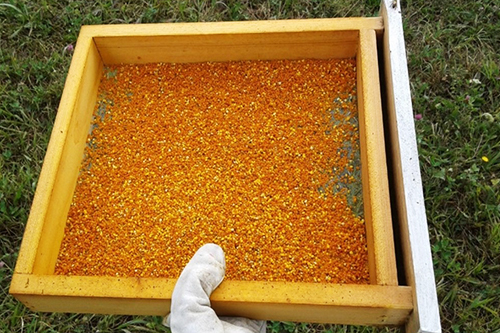
Pesticide Drift May Endanger Pollinators
Wind and water cause chemical pesticides to accumulate in bee-collected pollen and wax
The United States is home to more than 4,000 types of bees. Those beneficial insects are responsible for successfully pollinating the crops that feed the world’s growing population.
On the other hand, there are countless insects that attack, eat, and destroy those same plants. Agricultural producers often turn to chemical pesticides to protect their crops. Unfortunately, beneficial bees often fall victim to the same pesticides. To counter that, a group of scientists with the Agricultural Research Service (ARS) is working to protect the pollinators.
“Our research is to figure out how to keep the bees as healthy as possible while enabling pest control in the crops,” said Diana Cox-Foster, research leader at the ARS Pollinating Insect-Biology, Management, Systematics Research Unit (PIRU) in Logan, UT.
According to Cox-Foster, bees as pollinators are keystone species both for agricultural systems and for natural ecosystems, meaning that the bees are essential to the reproduction and health of the overall ecosystems.
“Without bees as pollinators, our food supply would be impacted,” she said, “with many of the nutritious fruits and vegetables not available or only available at high cost.”
The global annual value of crops pollinated by bees is estimated at nearly $580 billion, Cox-Foster said, with over 80% of plants worldwide requiring insect and other animal pollination for fruit and seed set. For human diets, bee pollination is essential for producing crops that provide many essential vitamins and nutrients. The current value of bee pollination in U.S. agriculture is estimated to be at least $18 billion.
 Researchers collect pollen from bee hives and analyze it for pesticide residues. (Photo by Caitlyn Horsch)
Researchers collect pollen from bee hives and analyze it for pesticide residues. (Photo by Caitlyn Horsch)
“Crop production in the United States is frequently limited by a lack of pollinators,” Cox-Foster said. “Honeybee colonies are currently the only bee species for which we have estimated losses. A survey released in June 2023 estimated the annual loss of colonies was 40%.”
In addition to honeybee losses, two bee species in the continental United States, the Rusty Patched Bumble Bee (Bombus affinis) and Franklin’s Bumble Bee (Bombus franklini), are on the Endangered Species List and nine other species are considered at risk. Factors involved in bee decline include climate change, disease, and pesticide exposure.
“From research performed on honeybee losses, we do have evidence that the ‘Four P’s’ (pesticides, pathogens, parasites, and poor nutrition) play a big role in colony losses with complex interactions between these factors; climate change also affects all of these,” Cox-Foster said.
ARS researchers have measured pesticide residues in samples of bees, wax, and bee-collected pollen. They found that, in many cases, pesticides that were applied elsewhere had been introduced into bee colonies through the pollen they had collected.
“Many pesticides detected in samples had not been used in the fields, indicating that pesticide exposures had to be occurring off the local farms where bees were placed [by beekeepers],” said Kelsey Graham, entomologist and lead ARS scientist on the project. “We now believe that this is a widespread problem.”
Some of these pesticides actively move with wind and water to go outside of their original application sites, while others are so stable that they do not degrade easily.
“It’s likely that many exposures are occurring due to off-target ‘drift’ onto plants that grow near crops, and not from pollinating the crops themselves,” Graham said.
Other research at PIRU is addressing new management strategies that can improve Integrated Pest and Pollination Management for different crops. The research asks if non-pesticide pest control measures can be implemented and, if pesticides are required, whether some pesticides can offer effective pest control but deliver minimal impacts on bee health and reproduction. – by Scott Elliott, ARS Office of Communications
You May Also Like:

